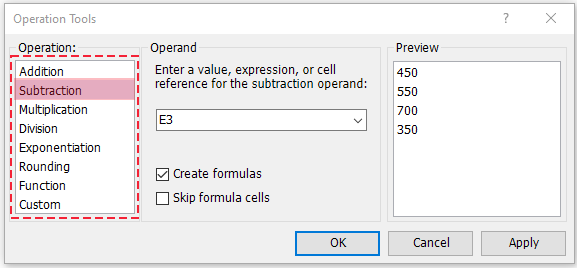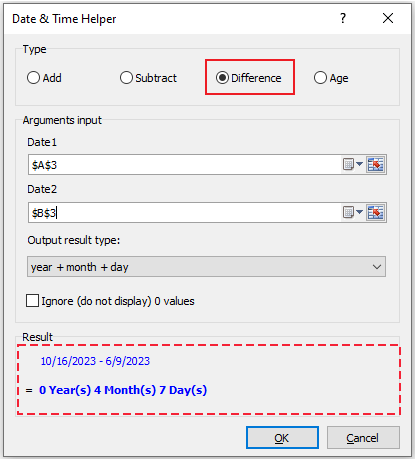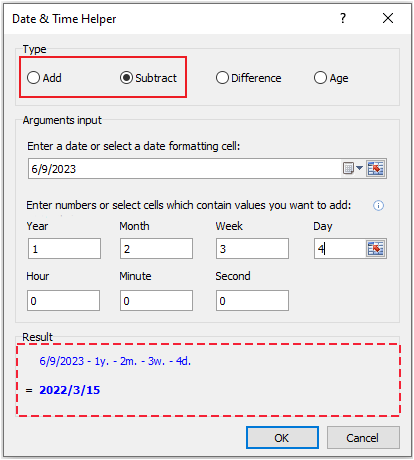Subtraction in Excel: Cells, Columns, Dates, and Times - A Full Tutorial
Subtraction is a fundamental operation in Microsoft Excel. In simple terms, it involves finding the difference between two values. Excel provides various tools for subtraction, from basic cell-to-cell operations to more advanced tasks involving columns, dates, and times. This tutorial will show you how to subtract in Excel by using the minus sign and SUM function, and guide you through scenarios, like subtracting cells, columns, dates, and times.
Excel Subtraction Formula
Before diving into specific scenarios, let's start with the basics of the Excel subtraction formula.
Because there is no SUBTRACT function in Excel, to perform a simple subtraction operation, you should use the - (minus sign) arithmetic operator. The subtraction formula follows a simple structure:
For example, to subtract 10 from 50, apply the below formula and get 40 as the result.
=50 - 10Now, let's break down subtraction in different contexts in the following content.
Subtract Cells in Excel
When it comes to subtracting cells in Excel, understanding the basics is crucial. Learn how to subtract one cell from another using a simple formula like =A1-B1 . Explore more advanced techniques by subtracting multiple cells from one, utilizing the Minus sign, the SUM function, and even summing negative numbers for intricate calculations.
Subtract One Cell from Another Cell
To subtract the contents of one cell from another, use the basic subtraction formula by employing the minus sign. Ensure to input cell references instead of numerical values.
For example, to subtract the number in cell B3 from the number in cell A3, apply the formula below in cell C3, and press the Enter key to get the result.
=A3 – B3
Subtract Multiple Cells from One Cell
Subtracting the contents of multiple cells from a single cell is a common operation in Excel. For example, we want to subtract cells B3, B4, and B5 from B2 like the below screenshot shows.

In this section, we'll delve into three methods to accomplish this goal.
Subtract Multiple Cells from One Cell by Using the Minus Sign
The most straightforward way to subtract the contents of multiple cells from one cell is by using the basic subtraction formula with the minus sign.
In cell B6, apply the formula below, and press the Enter key to get the result.
=B2 - B3 - B4 - B5
🌟 Batch add/subtract/multiply/divide values without formulas 🌟
Kutools for Excel’s Operation Tools utility makes it simple to apply operations without using formulas in cells. It lets you do basic operations like add, subtract, multiply, and divide. Beyond these, you can also do more complex calculations, such as rounding, exponentiation, or using custom expressions or functions. 💪

📊 Kutools for Excel: Your Time-Saving Excel Companion 🚀
Download NowSubtract Multiple Cells from One Cell by Using the SUM Function and the Minus Sign
Alternatively, you can use the SUM function to add up cells B3:B5 and then subtract the sum from the total in cell B2.
In cell B6, apply the formula below, and press the Enter key to get the result.
=B2 - SUM(B3:B5)
Subtract Multiple Cells from One Cell by Summing Negative Numbers
Adding a negative number is the same as subtracting it. To subtract multiple numbers from one number, please make sure the numbers you want to subtract are negative. (You can convert a positive number to negative by placing a minus sign before it.) Afterward, use the SUM function to add up all numbers.
In cell B6, apply the formula below, and press the Enter key to get the result.
=SUM(B2:B5)
Subtract Columns in Excel
Extend your subtraction skills to entire columns with this section. Discover how to subtract two columns row-by-row using basic formulas. Additionally, explore more advanced methods like subtracting the same number from a column using the Minus sign, leveraging smart tools for batch operations without formulas, and using the Paste Special feature for efficiency.
Subtract 2 Columns Row-by-Row
To subtract values in two columns row-by-row, use the basic subtraction formula with the minus sign in each row.
1. In cell C3, apply the formula below, and press the Enter key to get the result.
=A3 – B3
2. Drag the fill handle down to apply the formula to the entire column.

Because relative cell references are utilized, the formula will dynamically adjust for each row.
If you are using Excel for Microsoft 365, you can subtract the values in one column from another column row-by-row in a quicker way. You just need to apply the formula below in cell C3, and press the Enter key to get all results.
=A3:A6 - B3:B6
Subtract the Same Number from a Column
When working with spreadsheets, the need to subtract a constant value from an entire column is a common task. For example, we want to subtract the number in cell E3 from column B, like the below screenshot shows.

In this section, we'll delve into three methods to accomplish this goal.
Subtract the Same Number from a Column by Using the Minus Sign
Subtracting the same number from an entire column involves using the minus sign.
1. In cell C3, apply the formula below, and press the Enter key to get the result.
=B3 - $E$3
2. Drag the fill handle down to apply the formula to the entire column.

The crucial step is to use the $ sign to create an absolute cell reference, locking the reference to the cell to be subtracted. This ensures that it doesn't change when the formula is copied. In our case, when dragging the formula down, the absolute reference ($E$3) remains constant, while the relative reference (B3) adapts to each row, changing to B4, B5… in column B.
If you are using Excel for Microsoft 365, you can subtract the same number from a column even faster. You just need to apply the formula below in cell C3, and press the Enter key to get all results.
=B3:B6 - $E$3
Using a Smart Tool to Batch Subtract Without a Formula
If you are not a fan of formulas, the Operation Tools of Kutools for Excel is an excellent tool for you. This tool allows you to subtract a specific number from an entire column and output in the same range effortlessly. Additionally, it provides the flexibility to perform various operations like addition, multiplication, and more, making it a convenient option for users who prefer a formula-free approach.
After downloading and installing Kutools for Excel, select the data range (C3:C6) from which you want to subtract a number, and click Kutools >Operation. In the popping-up Operation Tools dialog, please do as follows.
- Select Subtraction in the Operation box.
- Input the number or cell reference in the Operand box; here I input E3. Click OK.

Result

Kutools for Excel - Supercharge Excel with over 300 essential tools, making your work faster and easier, and take advantage of AI features for smarter data processing and productivity. Get It Now
Subtract the Same Number from a Column by Using the Paste Special Feature
You can also use the Paste Special feature to subtract the same number from a column without formulas.
1. Select cell E3 and press Ctrl+ C to copy it.

2. Select range B3:B6, right-click on it, and click Paste Special from the drop-down menu.

3. In the Paste Special dialog, click Subtract in the Operation section. Click OK.

Result

Subtract Dates in Excel
To subtract dates in Excel, use the basic formula with the minus sign. For easy calculations, enter the dates in separate cells, and subtract one cell from the other.
For example, to subtract the date in cell B3 from the date in cell A3, apply the formula below in cell C3, and press the Enter key to get the result.
=B3 – A3

Date & Time Helper:
Get the difference between two dates/times
Effortlessly calculate the difference between two datetimes using the Date & Time Helper feature of Kutools for Excel. Output in various types, such as:
- year + month + day
- year + month + week + day
- hours + minutes + seconds ...
🚀 Kutools for Excel: Your Time-Saving Excel Companion
Subtract Times in Excel
Similarly, subtracting times is also accomplished by using the subtraction formula. For easy calculations, enter the times in separate cells, and subtract one cell from the other.
For example, to subtract time in cell B3 from the time in cell A3, apply the formula below in cell C3, and press the Enter key to get the result.
=B3 – A3

Date & Time Helper:
Add or Subtract date and time
Quickly add or subtract years, months, days, hours, minutes, or seconds to a datetime using the Date & Time Helper feature of Kutools for Excel.
🚀 Kutools for Excel: Your Time-Saving Excel Companion
In conclusion, Excel provides a plethora of methods to perform subtraction, whether you're dealing with cells, columns, dates, or times. Understanding these techniques will enhance your proficiency in data manipulation and analysis using Microsoft Excel. If you're looking to explore more Excel tips and tricks, please click here to access our extensive collection of over thousands of tutorials .
Related articles
How to sum or adding numbers in a single cell in Excel?
This article will show you methods of adding numbers in a single cell with details.
How to multiply two columns and then sum in Excel?
In Excel, there is a powerful function – SUMPRODUCT, with it, we can quickly multiply two columns and then sum them. This article, I will talk about how to apply this function.
How to print worksheet with displaying formulas in Excel?
Supposing you have a range of numbers, and now you want to multiply them by a number 8.7, do you have any effective and quick methods to deal with this task?
How to divide a range of cells by a number in Excel?
Sometimes, we may need to modify a range of cells in Excel quickly. For example, I have a range of cells which containing the prices of a group of products, and I want to divide all the prices by 2, and now here comes the question, how can I quickly divide a range of cells by a number?
The Best Office Productivity Tools
Kutools for Excel - Helps You To Stand Out From Crowd
Kutools for Excel Boasts Over 300 Features, Ensuring That What You Need is Just A Click Away...
Office Tab - Enable Tabbed Reading and Editing in Microsoft Office (include Excel)
- One second to switch between dozens of open documents!
- Reduce hundreds of mouse clicks for you every day, say goodbye to mouse hand.
- Increases your productivity by 50% when viewing and editing multiple documents.
- Brings Efficient Tabs to Office (include Excel), Just Like Chrome, Edge and Firefox.
Table of contents
- Excel subtraction formula
- Subtract cells in Excel
- Subtract one cell from another cell
- Subtract multiple cells from one cell
- By using the minus sign
- By using the SUM function and the minus sign
- By summing negative numbers
- Subtract columns in Excel
- Subtract 2 columns row-by-row
- Subtract the same number from a column
- By using the minus sign
- By using a smart tool to batch subtract without a formula
- By using the Paste Special feature
- Subtract dates in Excel
- Subtract times in Excel
- Related articles
- The Best Office Productivity Tools
- Comments

